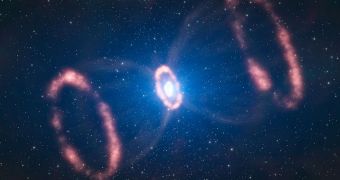When massive stars reach the end of their burning cycle, they explode in violent cosmic events known as supernovae. According to the latest computer models, just before the stars violently expel their atmospheres, they become very turbulent, which makes the explosion spread out matter unevenly in the former star's surroundings. This is precisely what astronomers at the European Southern Observatory (ESO) noticed when looking at SN 1987A, a famous supernova that exploded a short while ago.
The fact that the celestial body is located in the Large Magellanic Cloud (LMC), a galaxy located very close to the Milky Way, has made this particular stellar remnant a target for astronomical studies. The star that created it exploded back in 1987, in the first supernova seen from Earth in 383 years. Now, using the ESO Very Large Telescope (VLT), experts were able to peer deep into the debris field the supernova created, producing a three-dimensional image of how the material is distributed. This is the first time such measurements are conducted, and the preliminary conclusions appear to support the most recent computer simulations.
“We have established the velocity distribution of the inner ejecta of Supernova 1987A. Just how a supernova explodes is not very well understood, but the way the star exploded is imprinted on this inner material. We can see that this material was not ejected symmetrically in all directions, but rather seems to have had a preferred direction. Besides, this direction is different to what was expected from the position of the ring,” explains Karina Kjær, the lead author of the new ESO investigation.
“Integral field spectroscopy is a special technique where for each pixel we get information about the nature and velocity of the gas. This means that besides the normal picture we also have the velocity along the line of sight. Because we know the time that has passed since the explosion, and because the material is moving outwards freely, we can convert this velocity into a distance. This gives us a picture of the inner ejecta as seen straight on and from the side,” she adds, speaking about the technology the ESO group used to get its 3D view of SN 1987A.

 14 DAY TRIAL //
14 DAY TRIAL //